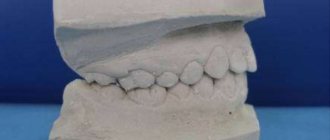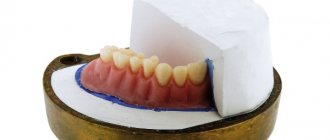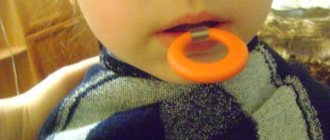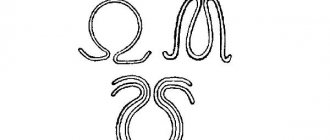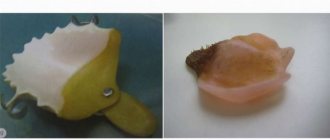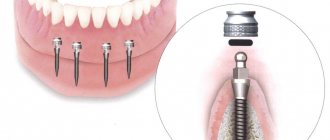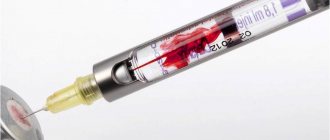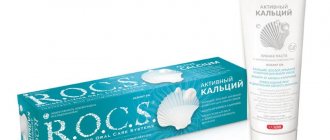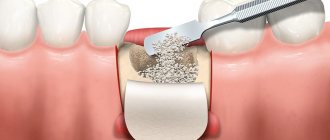3254
Correcting dental defects often requires major surgical procedures.
Restoration of bone tissue in the oral cavity and facial area after surgery is a pressing problem.
In this regard, the selection of effective drugs is very important for the successful treatment of teeth and jaw bones. One of these medications is KollapAn.
About the drug
The drug KollapAn is used for restoration of bone tissue, counteracting and treating suppuration and cystic formations.
The drug can replace damaged areas of bones, counteracts infectious phenomena for up to twenty days, uniformly providing an antibiotic effect.
The composition of the drug includes:
- synthetic hydroxyapatite;
- collagen compounds;
- active elements (lincomycin hydrochloride salts, gentamicin compounds, metronidazole, etc.).
Depending on the active element, subtypes of the drug are distinguished, which is reflected in the letter in the name. For example, KollapAna-L contains hydrochloride salts of lincomycin.
When using one or another subtype, you need to pay special attention to the active substance, since the speed of healing and the antibiotic effect, as well as the risk of developing allergic reactions, depend on its choice.
The use of antibiotics of different types and methods of action in the drug makes it possible to select the composition in such a way as to most effectively fight a particular infection and successfully suppress it.
Indications for oroantral communication plastic surgery and possible complications.
Read here about the properties and purpose of collagen membrane.
At this address https://www.vash-dentist.ru/hirurgiya/operatsii-na-zubah/koronoradikulyarnoy-separatsii.html you will find detailed information about performing coronoradicular tooth separation.
Types, composition and pharmacological properties
As noted above, preparations of the collapan group differ from each other in the type of active antimicrobial substance used in their manufacture.
So:
- the letter “G” means that the composition includes gentamicin elements;
- letter “K” - substances of the claforan group;
- letter "M" - metronidazole;
- letter “P” - antibiotics of the rifampic type;
- letter "D" - dioxidin;
- the letter “I” is an isoniazidine active substance.
CollapAn, according to the type of pharmacotherapeutic group, refers to drugs that fill the cavities of jaw fragments.
Pharmacological characteristics
The medication is a fine powdery composition of hydroxyapatite elements embedded in a collagen base with the addition of an antibiotic. Collagen has unique properties.
Due to its structure, it is non-toxic, non-carcinogenic, practically does not cause allergic reactions, is fully processed by the body, binds well to the active substances of drugs and triggers restoration processes in damaged areas.
The effect of the drug is based on the fact that the active substances do not penetrate the damaged areas immediately, but throughout the entire duration of its action.
This makes it possible to gradually restore bone tissue through the formation of calcium and phosphorus ions, which are introduced into the composition of the restored bone formations and accelerate healing.
The substances that make up KollapAn become the basis for the growth of restored areas . As they dissolve, they create growth points on themselves where active biological elements settle.
This process allows the formation of a prototype of the created solid fragments by accumulating minerals. The growth occurs directly on the drug molecules.
The emerging cartilaginous base then hardens and becomes mature bone. At the same time, the features of the drug allow you to avoid complications, there is practically no intolerance, which allows you to restore significant areas of damaged bones in a relatively short time.
Antimicrobial properties combined with the gradual release of the active substance provide reliable protection against inflammation throughout the entire treatment period.
The antibiotic procedure performed reduces the risk of further development of infectious processes.
Thus, KollapAn, thanks to an integrated approach, allows you to have an effective effect on damaged areas, restoring them health and strength.
Lower jaw implantation
The lower jaw is denser in structure than the upper jaw, so in most cases, 4 to 6 implants are enough to restore all teeth.
Fixed prosthetics of the lower jaw are performed on 6 implants with classical implantation. It is also possible to restore teeth on 4 implants using the all-on-4 method, in which case 2 of the 4 implants are placed at an angle of up to 45 degrees. The technique has its pros and cons.
Fixed prosthetics completely imitate your own teeth and are the easiest to tolerate psychologically. During the period of implant integration, the patient uses a temporary removable prosthesis, or dental implantation is carried out with a simultaneous load using a fixed plastic prosthesis.
In the case when a permanent prosthesis is made with screw fixation, we are talking about conditionally removable prosthetics on implants. Conditionally removable means that the prosthesis can only be removed by a dentist. The patient cannot remove it on his own; it feels and functions like his own teeth.
The advantages of screw fixation are that the prosthesis can be removed if necessary. Unlike cemented dentures, which cannot be removed without sawing them. However, the complexity of the design, and as a consequence the cost, is increasing.
Areas of application
Collapan is widely used in all areas related to the surgical treatment of bones, such as traumatology and orthopedic areas, neurosurgical procedures and surgical interventions for the treatment of the spine, elimination of suppuration and in the field of military surgery.
It is used to fill damaged areas and carry out antimicrobial treatment. To treat a specific infectious lesion, you can select a specific antibiotic included in the drug as an active substance. This allows for more effective therapy.
Surgical periodontology
During the surgical treatment of periodontal diseases , soft tissues are lifted, after which the surface is cleaned of mineralized formations of tartar, damaged fragments and bone tumors.
The doctor shapes the areas to be restored, sharp edges are processed. The operated areas are subjected to antimicrobial treatment and drying.
In areas where the fragment has failed and needs to be restored, portions of KollapAn are administered.
The video presents a scheme for the treatment of periodontitis using Kollapan granules.
Surgical dentistry
When removing teeth with complications, the remaining cavity from the root is diagnosed for dentin residues and potential bleeding, antimicrobial treatment and drying are performed.
A dose of the drug is placed in the cavity and the wound is treated. If there is a threat of alveolitis, additional procedures are performed under anesthesia, after which the damaged area once again undergoes antimicrobial therapy.
If the wound is bleeding, then Kollapan is applied and stitches are applied. In the future, the operated area does not require additional manipulations.
When truncation of a section of the tooth root and cupping of the damaged area, the resulting depression is filled with KollapAn, and blind sutures are applied. Thus, complete replacement of deleted areas with new fragments is ensured.
Dental implantation
After permanent prosthetics and implantation, damaged areas of the jaw that require rapid healing and visible parts of the dentures are treated with KollapAn.
This improves survival rate and eliminates the likelihood of developing suppuration and inflammatory processes.
When treating peri-implatitis diseases, the affected hard and soft tissues are diagnosed and cleaned. This removes inflammatory foci of the mucous membrane in the areas around the implants.
Treatment is carried out with antimicrobial agents and KollapAn, previously crushed and brought to a homogeneous state.
Sinus lifting procedures produce a serious impact on the jaw. A procedure is carried out to separate the soft tissues, the bone tissue is built up by filling it with KollapAn.
Maxillofacial Surgery
During such operations, defective areas of the facial bones are restored, and foci of infection are eliminated.
These can be either injuries or past illnesses. In this case, defects can be expressed in the presence of voids, curvatures, weakening and thinning of areas.
Therapy includes antimicrobial treatment, drying and filling with KollapAn substances.
In case of damage or puncture of the sinuses of the upper jaw, an examination is first performed, during which the degree of injury is revealed.
After this, the affected areas are removed from the cavity, the boundaries of the bone tissue located in the treatment area are processed, and treated with an antiseptic composition.
If suppuration is present, they are additionally disinfected . After this, the cavity is filled with the drug.
Stages of the operation to remove stones from the salivary gland and the equipment used.
In this article we will discuss indications for tooth reposition.
Follow the link https://www.vash-dentist.ru/hirurgiya/operatsii-na-zubah/kogda-opravdano-sekvestrektomii.html if you are interested in what sequestrectomy is and in what cases it is prescribed.
ALL-ON-4
The All-on-4 technique (all-on-four) was developed by Nobel Biocare. It involves the installation of 4 implants on one jaw with simultaneous loading with a fixed prosthesis on a screw fixation. The 2 outermost implants are placed at an angle of up to 45 degrees, which allows you to bypass anatomically difficult places: the maxillary sinuses in the upper jaw and the nerve exit site in the lower jaw.
Initially, the All-on-4 technique was positioned as minimally invasive, without bone grafting. However, for successful functioning it is necessary to install sufficiently long implants, because 4 implants must bear the load of the entire dentition. Unfortunately, not all patients have the required alveolar ridge height. Installing shorter implants may result in one of the implants not taking root due to increased load. And then everything-on-four will turn into nothing-on-three. This is why patients are offered “all-on-4 modifications”, for example All-on-6 (all-on-six implants), because Installing an additional 2 implants significantly reduces the risks.
3-6 months after implantation using the All-on-4 method, gaps appear between the prosthesis and the gum, because This is why gum remodeling occurs after implantation. It is necessary to either reline the existing prosthesis or replace it with a permanent one - metal-ceramic or zirconium.
Expected Result
X-ray studies show that within two to four months after using KollapAn:
- the restoration process began;
- healthy bone tissue was formed;
- defective areas were eliminated;
- within two years, signs of the disease disappeared.
When the drug is applied locally, in most patients, the damaged areas are completely replaced with a sponge-type mass.
There are practically no cases where KollapAn has no positive effect on the patient’s body.
Low effectiveness of treatment is only possible if the patient violates the doctor’s recommendations, or if the drug is used incorrectly, including an incorrectly selected antimicrobial substance.
The operated areas treated with the drug are quickly restored, there is no purulent discharge.
CollapAn can be combined with other restorative and antimicrobial medications , which can increase the effectiveness of treatment and reduce the risk of complications.
As a result, the patient can completely get rid of problems after suffering diseases of the maxillofacial region.
Cases of allergies to CollapAn, as well as contraindications due to intolerance to the drug, have not been identified.
Bone grafting for jaw implantation
The more implants are installed, the greater the likelihood that the existing bone tissue will not be enough to install implants and it will be necessary to build it up. Bone deficiency can be in thickness (very thin bone) or in height (close to the maxillary sinuses in the upper jaw, nerve in the lower jaw).
If there is a slight lack of bone tissue in thickness, one-step bone grafting with the installation of implants is possible. It is also possible to perform a sinus lift (a type of bone tissue augmentation when the distance to the maxillary sinus is insufficient) with the simultaneous installation of implants.
If there is a large deficiency of bone tissue, operations are first performed to build it up (open sinus lift, harvesting and replanting of a bone block), and after 3-6 months, implantation is performed. In this case, the total duration of treatment can be from one to one and a half years.
Reviews
Recovery after surgery in the mouth and jaw is a very painful process.
Many factors can interfere with healing. Today there are many drugs on the pharmaceutical market. But from them I want to choose the most effective at an affordable price.
Those who have encountered similar problems and used drugs for treatment that restore the jaw bone (including KollapAn), we advise you to leave your feedback in the comments section.
If you find an error, please select a piece of text and press Ctrl+Enter.
Tags medicines operation
Did you like the article? stay tuned
Previous article
Purpose of Ribbon tape in dentistry and functions assigned to the product
Next article
Distalization of molars – correction of bite defects at any age
How much does implantation cost if there are no teeth?
Despite the apparent high cost of implantation in the absence of teeth, it may turn out to be more profitable than restoring already hopeless teeth. In addition, the service life of implants is unlimited. Treatment is carried out in stages and is also paid for.
So, the price of jaw implantation in the absence of teeth depends on the type of structure (metal-plastic, metal-ceramic) and the implant system.
The cost of jaw implantation on 6 ROOT implants (Switzerland) with a metal-plastic prosthesis starts from 150,000 rubles. It is possible to replace the metal-plastic structure with a metal-ceramic one at a cost of 90,000 rubles.
The cost of jaw implantation on 4 Snucone implants (South Korea) with a metal-plastic prosthesis starts from 160,000 rubles.
